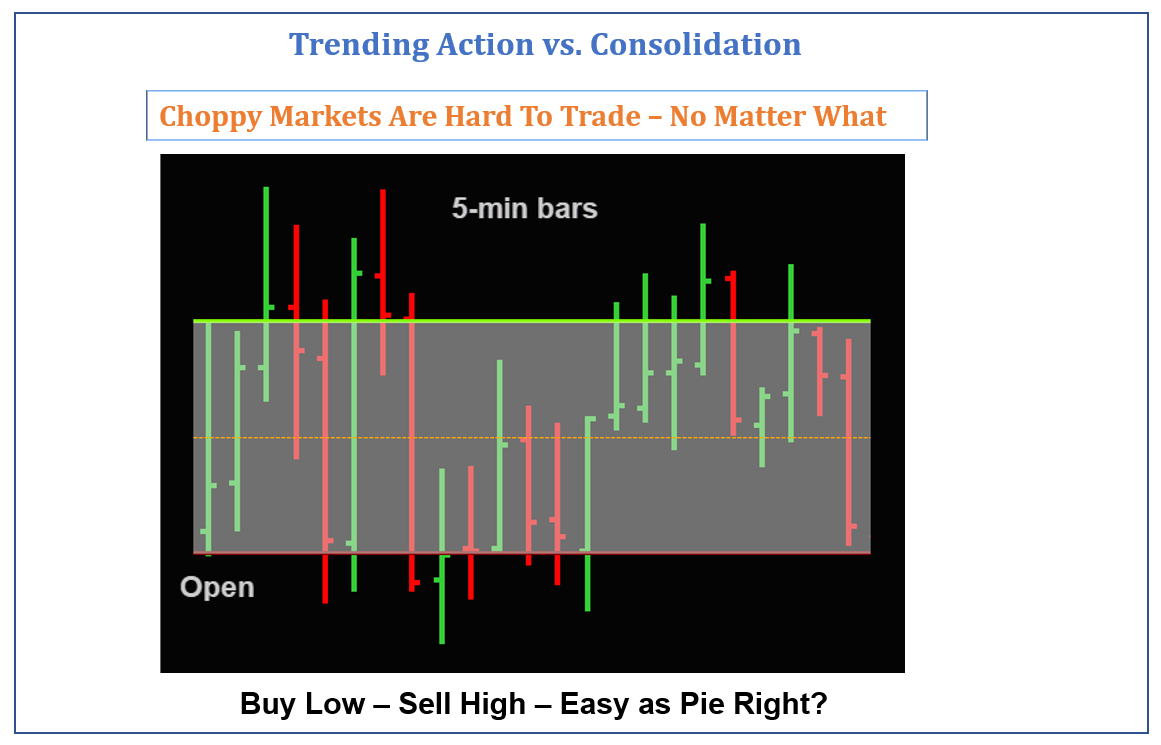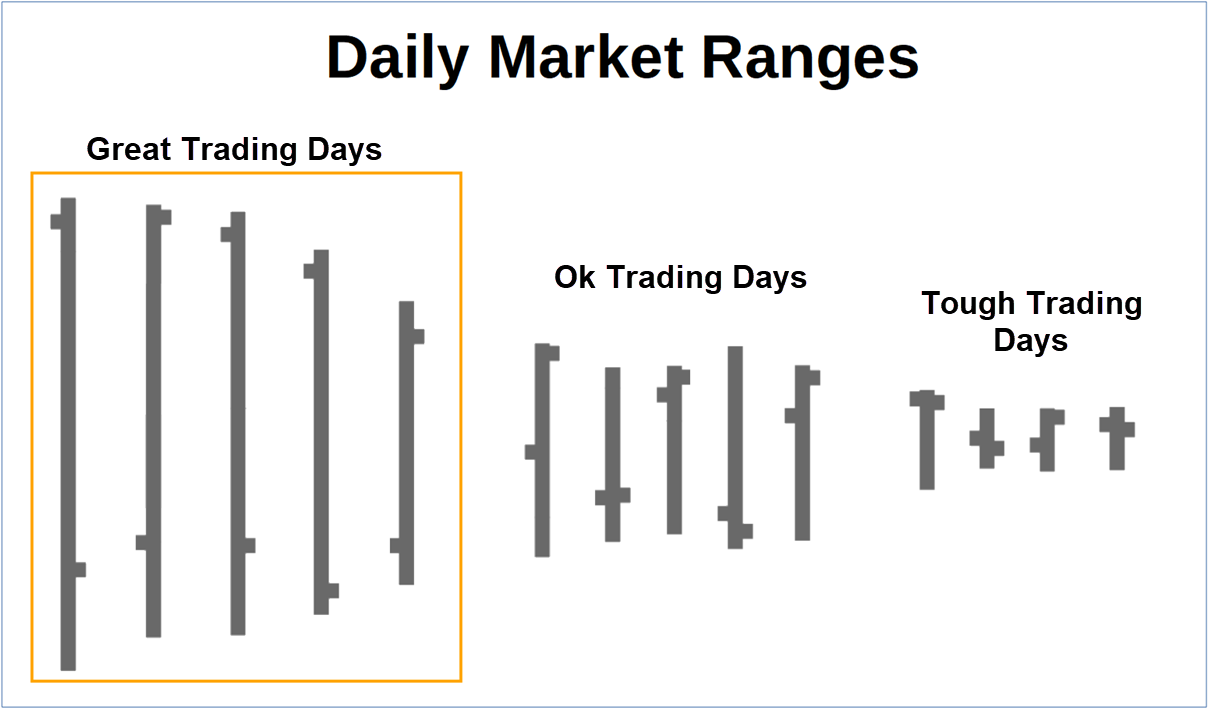Day to Day Market Conditions Affect the Results of Every Trading System
Ideally the market would serve up great trading days every session – but it just doesn’t work that way.
Most traders have a hard time handling the day-to-day inconsistency of price action. Underestimating the trickiness and day-to-day personality changes in the futures market can completely throw a new trader off balance before they even have a chance to find their sea legs. There is this idea that the market is orderly and cyclical and has some secret underlying “mathematical symmetry” which just has to be discovered and tapped into to be able to cash in big. Market price movement is NOT consistent – which easily throws a monkey wrench into most trading approaches. We may see several days of low momentum chop followed by explosive trending action for a few days which can take you by surprise. Quit trying to figure out the market and instead focus on learning how to play it.
You cannot “Figure Out” the market… you can only attempt to exploit it.
You can’t force the market to behave in a certain way – or expect that it’s going to accommodate your style of trading every session. Some days the price action is so dull you’re better off doing anything than trying to trade. This is especially true in sideways market conditions. I’ve seen price clang around in a few point range for hours on end without offering any decent trading opportunities.
You have to trade what the market is serving up today. And it’s important to not get frustrated and just realize conditions will improve (they always do). Trading out of boredom – or forcing trades just because you think “I’m a trader I need to be trading” is one of the pitfalls many people fall into. That’s also related to the problem of over-trading. Some people think they need to constantly be jumping in and out just because the market is open. If there are no waves, you can’t surf. If there’s no wind you can’t sail.
Intraday market conditions can vary drastically too. We tend to see dull price action around lunchtime (East Coast). The action is usually better in the morning and afternoon, but that can vary a lot too. There’s “seasonality” that comes into play too. July and August are typically dull. The week between Christmas and New Year is not usually the best trading environment.
Adjusting to market conditions (both intraday and over longer-term cycles) and keeping your expectations relative to current conditions is the correct approach. Every market session is unique. The price action manifests differently.
Knowing when NOT to trade is also important.
Some “market conditions” are ideal for trading and some are not as conducive:
-
– Holidays / 3-day weekends – The week between Christmas and New Year
– July and August tend to be dull, low-participation
– Waiting on “news” — or – boring low-volume price action for no reason
– “Stuck in a Range” sideways consolidation periods
Avoid “unrealistic expectations” in sub-optimal market conditions.

The Power Trend System will attempt to keep us out of choppy, non-trending market conditions like you see on the image above.
The important thing is to not get frustrated when there are no Alerts or trades for periods of time. The system is designed to swing at the “fat pitches” and avoid choppy sideways price behavior.
Slow Markets – Fast Markets – Normal Markets
Market conditions generally fall into 3 categories, which can vary from day to day but typically last for weeks.
Slow markets are typical in July and August where it seems like the price action is moving in slow motion – trading like molasses. The price tends to trade in a dull choppy range and there’s a tendency for erratic almost random price moves. there’s no “flow” to the action – it’s choppy, dull, boring and random. We’ve seen a lot of this type of price action with the VIX under 20. Some traders have probably not experienced “fast markets” except maybe on Fed days. Slow markets are common during consolidation periods on the daily timeframe. In other words, when the market has a “run” on the daily timeframe, generally speaking it reaches a level where it begins consolidates the move. The price action slows down and the ranges contract. You’ll see a series of Doji’s and the daily chart is likely to be range bound. Slow markets aren’t all that conducive to trading. (Globex trading is usually a good example of a slow market).
If the VIX is under 20 you’re likely to experience “slow market sessions”.
Normal Markets – is there such a thing? Yes, and they are the best trading environment overall. There’s good volume and price movement, plenty of trending action and the market participants are engaged.
Fast markets – these are usually the best conditions for scoring big points – but also come with the most risk. Examples of fast markets are the Pandemic sell-off where SPX price was moving 1-2% a day. And the beginning of 2022 when Russia invaded Ukraine. Prior to that the 2016 election and the period of time around Brexit (if you remember back that far). Fast markets are a double-edge sword because the price can move 20-30 ES points in the blink of an eye. I remember seeing ES move 30 points in a 1-minute price bar. (the good old days?)
HERE’S A FACT: THE MARKET WILL EXPERIENCE LONG-RANGE DAYS – GUARANTEED
By long-range day I mean a session where the price trends significantly in one direction. A day where ES moves say 30-50-75 points in one direction from open to close. In slow market conditions you might go a couple weeks without having a BIG up or down day. In volatile periods you might see several days like that in a week or two week period. You might see several days in a row where the market makes a huge move – typically as the result of some news events or something happening in the world.
Since we know there will be – and always has been huge intraday moves – the question is – can we be patient and wait for them? or are we going to blow our account being over-zealous trying to force trades when the market is flat? And do we have a plan for when those big trending days happen – to take advantage of it and score the BIG points?
A potential user commented: “The biggest problem I’ve always had was holding onto winners long enough to score big points. I always sell to quickly”. So that is the big conundrum. How do you “let your winners run” as the saying goes? Well, it plays into everything I’ve been saying here. Adjust your expectations and trading based on market conditions – and when things heat up – THEN you shoot for the big scores. The good news is that the software handles this automatically. When major trend moves occur, the software will likely have us in for the bulk of the move. We don’t have to worry about “selling too soon” because the Trailing Stops handle the selling for us. They solve the dilemma of “when should I sell?”.
Trading is a game of odds and tolerances and the system gives us an “edge” over the series.
The key to consistent success trading futures is stacking the odds in our favor. Trading is a game of odds and the only way to compensate for the seemingly random intraday price movements is to have an “edge”. What I mean is that we need to take a systematic approach and realize that we can’t just wing it from day to day. When you’ve been trading intraday price movements for a while you realize that a lot of time the price movement tends to be almost completely random at times. Other times it behaves just like you read in the technical analysis books.
Adjusting our expectations and our approach based on what we see unfolding in today’s session is important.
We want to trade more aggressively in good market conditions and more conservatively in “sub-optimal” market conditions. This is mainly achieved by scaling the number of Contracts we trade as well as choosing whether to take profits (or losses) quickly or let things open up and shoot for bigger point gains.
The Power Trend System provides an edge and stacks the odds in our favor. Its logic is programmed to adjust to varying market conditions, but this only goes so far. In other words it’s job is to get us into Trend moves, but the follow-through and whether there’s enough momentum to carry it to both targets and beyond is subject to market conditions at the time.

The great thing about the Power Trend System is that the Targets and Stops adapt to be consistent with the current price action. On long-range days the stops will be wider and the targets further out. On narrow-range days the stops and targets will be closer in. That makes perfect sense and is one of the reasons it uses the current ATR’s and ranges in the market to determine the levels.
A good Trading System or Strategy adapts to current market conditions – and also adapts to an ever-changing market environment.